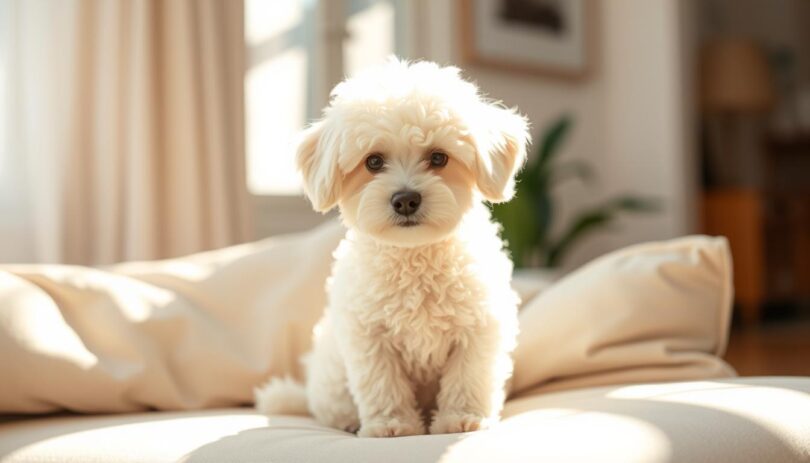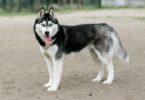What if the perfect family pet isn’t a purebred but a clever mix of two beloved breeds? Meet the Bichpoo – a charming hybrid combining the playful Bichon Frise and the intelligent Poodle. This designer dog offers more than just irresistible curls and button eyes. Its hypoallergenic coat and adaptable nature make it a top choice for modern pet owners.
As a cross between the Bichon Frise and Poodle, this breed inherits the best traits from both parents. Expect a loyal companion with low-shedding fur, ideal for allergy sufferers. Their friendly temperament shines in apartments or houses, making them versatile for city dwellers and suburban families alike.
This guide covers everything you need to know. Learn about grooming routines to keep their coat fluffy and healthy. Discover training tips that work with their eager-to-please personality. We’ll also explore common health considerations and how to create an enriching environment for your pet.
Why are Bichpoos rising in popularity? Their combination of intelligence, affection, and manageable size checks all the boxes for busy households. Whether you’re a first-time owner or a seasoned pet enthusiast, this breed’s unique qualities make sure every day feels rewarding.
Discovering the Charm of the Bichpoo
Families seeking a loyal companion with brains and beauty often find their match in this Bichon Frise-Poodle mix. These dogs blend the best qualities of both parent breeds into one irresistible package. Their popularity isn’t just about looks—it’s about creating joyful connections in homes across the U.S.
What Makes Bichpoos Stand Out
Intelligence meets affection in these curly-coated companions. The Bichon’s cheerful personality pairs with the Poodle’s sharp mind, creating a dog that learns tricks quickly and thrives on human interaction. Unlike many small breeds, they maintain puppy-like energy without becoming overly demanding.
Their hypoallergenic coats set them apart from other dogs. Tight curls trap loose hair, reducing shedding and allergens. Combined with expressive eyes and a plush teddy bear appearance, this breed wins hearts at first glance.
Designer Dog Appeal for Families
Modern households love these hybrids for their adaptability. Whether in apartments or suburban homes, they adjust to various lifestyles. Their gentle nature makes them safe around children, while their playful streak keeps families entertained.
Low-maintenance grooming needs add to their family-friendly reputation. Weekly brushing prevents mats, and their compact size simplifies care routines. For allergy sufferers or busy pet owners, this breed offers the perfect balance of charm and practicality.
The History and Origins of Bichpoos
Tracing this hybrid’s lineage reveals a story woven through royal courts and modern breeding labs. Both parent breeds carry legacies that shaped today’s beloved companion.
European and Royal Beginnings
The Bichon Frise rose to fame in 14th-century Europe as a favorite of nobility. Spanish sailors brought these dogs to the continent, where their cheerful nature charmed royalty. French and Italian aristocrats often showcased them as living ornaments, valuing their hypoallergenic coats and lively personalities.
Poodles boast an even older heritage, dating to Roman times. Originally bred as water retrievers, their intelligence made them stars in circuses and hunting expeditions. This mix of elegance and utility laid the groundwork for future crossbreeds.
The Modern Development in Australia
Australian breeders in the 1990s pioneered intentional Bichpoo breeding. They focused on enhancing health and temperament through selective pairings. Years of refinement produced dogs with consistent curly coats and friendly dispositions.
Early owners prized these hybrids for combining the Bichon’s charm with the Poodle’s low-shedding traits. Today, responsible breeding practices prioritize genetic diversity to address common health concerns. This approach ensures the breed remains a joyful, resilient companion for modern households.
Bichpoo Appearance, Size, and Coat Characteristics
A dog’s physical attributes often determine how well they fit into different lifestyles. This hybrid’s compact build and soft curls make it instantly recognizable. Standing 9-15 inches tall and weighing 6-18 pounds, their proportions suit both apartments and larger homes.
Physical Traits and Color Variations
These dogs inherit traits from both parent breeds. Some showcase the Bichon Frise’s rounded eyes, while others display the Poodle’s athletic frame. Coat textures range from tight curls to loose waves in shades like cream, apricot, or multi-colored patterns.
Size variations depend on whether the Poodle parent was toy or miniature. Smaller versions thrive in urban spaces, while slightly larger ones adapt well to active households. Their teddy bear-like appearance remains consistent across all sizes.
Understanding Their Coat and Grooming Needs
Though hypoallergenic, their dense fur demands weekly attention. Daily brushing prevents mats, especially behind ears and under legs. Use a slicker brush and detangling spray for stubborn knots.
Professional grooming every 4-6 weeks maintains coat health. Trim nails monthly and clean ears weekly to prevent infections. Dental chews support oral hygiene between brushings.
Essential Bichpoo Care and Grooming Tips
A well-maintained coat does more than enhance appearance—it safeguards your pet’s health and comfort. Establishing smart routines helps prevent common issues while strengthening the bond between owner and dog.
Daily Grooming Practices
Start each day with a 5-minute brushing session using a slicker brush. Work through the coat in sections, focusing on areas prone to tangles like behind the ears. For stubborn knots, spray a detangling solution before gently combing them out.
Involve children in light brushing tasks using soft-bristle brushes. This teaches responsibility while creating positive interactions. Always follow brushing with a quick paw inspection to remove debris from outdoor adventures.
Preventing Matting and Skin Issues
Schedule professional trims every 4-6 weeks to maintain manageable coat length. At home, use hypoallergenic shampoo during monthly baths to avoid irritating sensitive skin. Dry thoroughly with a cool hairdryer to prevent moisture-related infections.
Weekly ear cleanings with vet-approved solutions reduce infection risks. Check between paw pads for trapped dirt after walks. Families should rotate grooming tasks to ensure consistent care while making it a shared activity.
Consistent grooming not only keeps the coat shiny but also extends your companion’s active life. Early detection of skin changes during brushing sessions allows prompt treatment, keeping your pet happy and healthy for years.
Mastering Bichpoo Training and Socialization
Unlocking a hybrid dog’s full potential starts with tailored training strategies. Combining the Poodle’s sharp intellect and the Bichon Frise’s eagerness to please, this breed thrives when sessions feel like playtime. Owners who blend consistency with creativity often see remarkable results.
Positive Reinforcement Works Best
Reward-based methods yield quick progress with these clever dogs. Treats, praise, or a favorite toy reinforce desired behaviors like sitting or staying. Short 10-minute sessions spread throughout the day prevent boredom while building skills.
Leash training becomes smoother when paired with high-value rewards. For housebreaking, establish regular outdoor routines and celebrate successes immediately. Puzzles that dispense treats keep their minds engaged between structured lessons.
Building Confidence Through Exposure
Early socialization shapes a well-adjusted companion. Introduce puppies to diverse sounds, surfaces, and friendly strangers by 16 weeks. Controlled playdates teach polite interactions with other pets.
At home, practice handling paws and ears to simplify grooming later. Pair new experiences with calm reassurance to build trust. For comprehensive strategies, explore this complete guide to expert puppy training.
Feeding Your New Bichpoo: Nutrition Insights
Proper nutrition forms the cornerstone of any thriving companion animal’s well-being. For small hybrids like this Bichon-Poodle mix, tailored meal plans prevent common health issues while supporting their energetic lifestyle. Let’s explore how to fuel their growth and vitality through every life stage.
Puppy Diet Versus Adult Nutrition
Puppies require nutrient-dense formulas with 25-30% protein to support rapid development. Look for foods containing DHA for brain health and calcium for bone strength. Feed three to four small meals daily to stabilize energy levels in dogs under 12 inches tall.
Adults thrive on two measured meals with lean proteins like chicken or salmon. Their smaller jaws benefit from kibble designed for breeds under 18 pounds. Avoid overfeeding to prevent obesity—a common issue linked to joint disease in compact dogs.
High-quality options mirror the robust genetics inherited from their parents. Whole-food ingredients like sweet potatoes and flaxseed promote skin health while reducing allergy risks. Steer clear of fillers like corn or soy, which may trigger digestive issues.
Portion control proves critical for preventing diet-related diseases. Use a kitchen scale to measure servings based on weight rather than volume. Pair this approach with annual vet consultations to adjust for activity changes or age-related needs.
Understanding Bichpoo Temperament and Personality
A dog’s personality often determines its success as a household companion. This designer breed shines with a blend of playfulness and calmness that suits diverse family dynamics. Their adaptable nature makes them equally content snuggling with seniors or playing fetch with energetic children.
Sweet-Natured Companions for All Ages
These hybrids thrive on human interaction, forming strong bonds with every family member. Their gentle demeanor prevents nipping or rough play, even during lively interactions with toddlers. Seniors appreciate their moderate exercise needs and affectionate lap-dog tendencies.
Despite their lively bursts of energy, these dogs maintain an easygoing attitude. Daily walks and puzzle toys satisfy their activity requirements without overwhelming busy owners. Their intelligence allows them to read household routines, adapting seamlessly to changing schedules.
The breed’s high-quality hair contributes to its hypoallergenic reputation. Tight curls trap dander, reducing allergic reactions for sensitive individuals. Regular grooming care keeps their coat healthy while minimizing shedding.
Prospective owners should note potential genetic predispositions. While generally robust, some lines may develop cataracts later in life. Early veterinary care and routine eye checks help manage this condition effectively.
Health Considerations and Preventive Care for Bichpoos
Proactive health management ensures these companion animals enjoy long, vibrant lives. While generally robust, their mixed lineage carries genetic predispositions requiring attention from puppyhood through senior years.
Common Genetic and Age-Related Issues
Patellar luxation affects many small breeds, causing kneecap displacement during activity. Annual vet exams help catch this early. Progressive retinal atrophy may develop later, gradually impairing vision—genetic testing identifies at-risk puppies.
Hip dysplasia appears less frequently but warrants monitoring in active animals. Skin sensitivities often emerge from environmental triggers. Weekly ear cleanings and hypoallergenic shampoos prevent irritation. Senior dogs might develop cataracts, manageable through early detection.
Importance of Regular Vet Checkups and Insurance
Bi-annual vet visits allow professionals to track weight, dental health, and energy levels. Bloodwork at age two establishes baseline metrics for future comparisons. Pet insurance proves valuable when addressing unexpected conditions like Legg-Calvé-Perthes disease.
Maintaining proper energy expenditure through daily walks reduces obesity risks. Puzzle toys combine mental stimulation with calorie burning. For families, combining preventive care with insurance creates financial security while prioritizing their pet’s well-being.
Selecting a Reputable Bichpoo Breeder
A responsible breeder lays the foundation for a happy, healthy family addition. Ethical practices ensure puppies inherit the Bichon Frise’s cheerful temperament and Poodle’s intelligence while minimizing health risks. Start your search by verifying credentials like AKC 5-Star Breeder status and 20+ years of experience.
Essential Questions and Warning Signs
Ask breeders about genetic testing for parents, including eye exams and hip screenings. Reputable providers share health certificates and vaccination records upfront. Inquire about socialization practices—puppies raised with daily exercise and family interaction adapt better to homes.
Red flags include breeders who refuse home visits or pressure quick deposits. Avoid those advertising “rare color” surcharges or withholding medical history. Inspect living conditions personally: clean spaces and visible parent dogs indicate quality care.
Evaluate a puppy’s appearance for bright eyes and a shiny coat, hallmarks of good health. Request dietary plans used during weaning to maintain consistency. Breeders matching temperaments to family lifestyles often provide trial periods or refunds if placements fail.
Prioritize transparency in lineage documentation and genetic health guarantees. Trustworthy breeders maintain open communication post-adoption, offering guidance through your pet’s developmental stages. This diligence ensures your Bichpoo thrives as a joyful family member for years.
Living with a Bichpoo in Various Home Environments
Adaptable companions thrive when their environment matches their energy and care requirements. These hybrids excel in diverse settings, from compact city apartments to active family homes. Their moderate exercise needs and people-oriented nature make them versatile household members.
Adapting to Apartment Living
Small size (9-15 inches tall) and quiet demeanor make these pets ideal for tight spaces. Wall-mounted beds maximize floor space, while washable pee pads simplify bathroom routines. Rotate puzzle toys weekly to engage their sharp minds without clutter.
Daily 30-minute walks meet exercise needs in urban areas. Create a cozy corner with chew toys and soft blankets for downtime. Soundproof curtains help minimize noise during play sessions with kids or other pets.
Creating a Pet-Friendly Home for Active Families
Families with kids benefit from clear rules about gentle handling. Use baby gates to separate play zones from quiet areas. Store small objects in locked cabinets to prevent choking hazards.
Reduce allergens by vacuuming twice weekly with HEPA filters. Bathe your pet every 3-4 weeks using hypoallergenic shampoo. Consistent feeding schedules and interactive games support their calm temperament.
Balance physical activity with mental challenges like treat-dispensing toys. Evening cuddle sessions reinforce bonding while helping wind down energetic pets. These strategies create harmony for both two-legged and four-legged family members.
Wrapping Up Your Bichpoo Journey
Choosing the right companion involves balancing practical needs with emotional connection. This guide has explored how the Bichon Frise-Poodle mix excels in both areas, offering hypoallergenic coats and adaptable personalities. From daily brushing routines to positive reinforcement training, owners gain tools for raising a well-adjusted pet.
Tailored food plans with proper portions and quality ingredients support energy levels and overall health. Regular vet visits and preventive care extend their 12- to 15-year lifespan through proactive measures. Their compact size and apartment-friendly nature help them thrive in urban settings or cozy homes.
Vibrant coat colors—from creamy whites to rich apricots—highlight this hybrid’s visual appeal. Apartment dwellers benefit from their moderate exercise needs and adaptable temperament. Prospective owners should prioritize reputable sources and consistent care routines.
By understanding these dogs’ unique requirements, families ensure years of joyful companionship built on trust and informed choices. Always consult professionals to maintain your pet’s well-being, creating a happy future for both human and canine members of your household.
FAQ
How long do Bichon Frise Poodle mixes typically live?
These designer dogs usually live 12–15 years with proper care. Their lifespan depends on diet, exercise routines, and regular veterinary checkups to address genetic conditions like patellar luxation or eye issues.
Are Bichpoos hypoallergenic for owners with allergies?
Their low-shedding, curly coat produces less dander than many breeds, making them a better option for mild allergy sufferers. However, no dog is fully hypoallergenic—regular grooming minimizes allergens in your home.
Can they adapt to apartment living?
Yes! Their compact size (9–15 inches tall) and moderate energy levels suit smaller spaces. Daily walks and interactive toys help meet their exercise needs without requiring large yards.
What’s the ideal exercise routine for this crossbreed?
Aim for 30–60 minutes daily, split between walks and playtime. Mental stimulation through puzzle toys or training sessions prevents boredom-related behaviors like chewing.










Leave a Comment